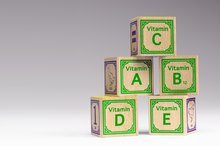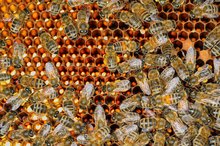Concerns on Gummy Vitamins
With their bright colors and fun shapes, gummy vitamins have taken the dietary supplement market by storm. Gummy vitamins are no longer just for children -- several manufacturers have introduced adult versions of vitamin supplements in the form of soft and chewy gummies for those who have difficulty swallowing pills.
Accidental Overdose
The greatest concern with gummy vitamins for children is that they can be mistaken for candy. Like gummy candies, children’s gummy vitamins are appealing to eat because they come in numerous colors and soft shapes -- from animals to cartoon characters -- and they taste like candy.
Be sure to keep gummy vitamins out of your child’s reach and give the child only the recommended dose. You should also tell your children that the vitamins are not candy and that eating too many can make them sick.
- The greatest concern with gummy vitamins for children is that they can be mistaken for candy.
Ingredients
Flintstone Vitamins Side Effects
Learn More
A University of Wisconsin Medical Center review of vitamins found that gummy vitamins are “nutritionally incomplete,” meaning they don’t contain a broad range of vitamins and minerals. Compare the "% Daily Value" columns on vitamin product labels to be sure the product you choose provides adequate amounts of nutrients to be beneficial to your health.
Some gummy vitamin products include gelatin, which comes from animal collagen, as a binder. If your family is vegetarian, or if your child cannot eat animal products for any other reason, you should check the label of the product you choose for evidence of gelatin. There are vegetarian gummy formulas available that use fruit pectin instead of gelatin.
- A University of Wisconsin Medical Center review of vitamins found that gummy vitamins are “nutritionally incomplete,” meaning they don’t contain a broad range of vitamins and minerals.
Safe Storage
Unlike most vitamins, gummy vitamins may require constant temperatures and refrigeration to prevent spoilage. Check the label of the product you choose for storage requirements. Having gummies in the fridge may make it harder to keep them out of your child's reach -- be aware of this when you choose a storage place.
Gummy vitamins will melt in high heat. In addition to affecting the portion size, high temperatures can cause vitamins B and C and other water-soluble vitamins to disintegrate.
- Unlike most vitamins, gummy vitamins may require constant temperatures and refrigeration to prevent spoilage.
- In addition to affecting the portion size, high temperatures can cause vitamins B and C and other water-soluble vitamins to disintegrate.
Vitamins Shouldn’t Replace a Balanced Diet
What If My Child Ate Too Many Vitamins?
Learn More
Vitamins and other dietary supplements are not a good substitute for a healthy, balanced diet. The American Academy of Pediatrics advises that healthy children eating a well-balanced diet that includes 400 IU of vitamin D, do not need vitamin supplementation 1.
If you are concerned that you or your children are not getting adequate amounts of nutrients from your daily diet, check with your doctor or your child’s pediatrician to determine what you need and how much to take.
Related Articles
References
- American Academy of Pediatrics: Where We Stand: Vitamins
- National Institutes of Health Office of Dietary Supplements. Iodine. Updated September 18, 2020.
- Sudha MR, Jayanthi N, Aasin M, Dhanashri RD, Anirudh T. Efficacy of Bacillus coagulans Unique IS2 in treatment of irritable bowel syndrome in children: a double blind, randomised placebo controlled study. Benef Microbes. 2018;9(4):563-572. doi:10.3920/BM2017.0129
- Swanson D, Block R, Mousa SA. Omega-3 Fatty Acids EPA and DHA: Health Benefits Throughout Life. Adv Nutr. 2012;3(1):1-7. doi:10.3945/an.111.000893
- Ströhle A, Hahn A. Vitamin C und immunfunktion [Vitamin C and immune function]. Med Monatsschr Pharm. 2009;32(2):49-56.
- National Institutes of Health Office of Dietary Supplements. Vitamin D fact sheet for health professionals. Updated October 9, 2020.
- Rahmani AH, Alsahli MA, Aly SM, Khan MA, Aldebasi YH. Role of Curcumin in Disease Prevention and Treatment. Adv Biomed Res. 2018;7:38. doi:10.4103/abr.abr_147_16
- Johnson RK, Appel LJ, Brands M, et al. Dietary Sugars Intake and Cardiovascular Health: A Scientific Statement from the American Heart Association. Circulation. 2009;120(11):1011-1020. doi:10.1161/CIRCULATIONAHA.109.192627
Writer Bio
Kat McCallum has been a full-time medical writer since 2004. Her writing is found in "Lancet Neurology" and "Oncology News International," and on AuntMinnie.com, a website for radiologists. She also held communication leadership positions at the American Academy of Neurology and the Minnesota Trade Office. McCallum has a Bachelor of Arts in communications and political science from the University of Minnesota.









